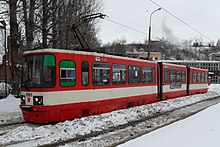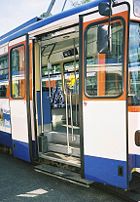Low-floor tram

A low-floor tram is a tram that has no steps between one or more entrances and part or all of the passenger cabin. The low-floor design improves the accessibility of the tram for the public, and also may provide larger windows and more airspace.[1]
A low-floor tram allows accessible level access from curb level platforms. Level access can also be achieved either by using a high-floor vehicle serving high-platform stops. Currently both types are in use, depending on the station platform infrastructure in existing rail systems. Some systems may make use of former railway alignments where use of existing high platforms is desirable, while others, particularly new systems, may not have the space to site high-level platforms in urban centres.
Low-floor tram configurations
[edit]Trams traditionally had high floors, and articulated tram designs evolved with low-floor centre sections. Examples of this design are Amsterdam 11G/12G-trams and the Kusttrams in Belgium.
The most common design of 100% low floor vehicles[citation needed] is the multi-articulated design. This uses short carbody sections for the wheels with longer sections between them. Examples of this are the Alstom Citadis and Combino. A different design was developed by MAN. In 1990 the GT6N was the first 100% low-floor tram. These trams are found in ten German cities (such as Bremen and Munich) and in the Swedish city Norrköping. Other designs are only partially low floor, with high floors over the bogies at the outer ends and single axle bogies under the low-floor centre section. North American light rail type vehicles frequently have a similar configuration but with a centre bogie designed to accommodate a low floor situated under a short centre section.
In Vienna, Ultra Low Floor (ULF) Trams can "kneel" at the curbside, reducing the height from the road to only 180 mm (7.1 in).

Some public transport companies have both low floor and high floor trams. They report that low floor trams have 15% higher maintenance costs for the rolling stock, and 20% higher maintenance costs for the infrastructure on average.[2]
Many low-floor trams have fixed bogies[3] which increase track wear and tear, while decreasing the speed at which a tram can drive through a curve (usually 4–15 km/h (2.5–9.3 mph) in 20 m (66 ft) radius curve).[4] The Škoda ForCity and the newest Alstom Citadis X04 try to counter the effect with pivoting bogies while maintaining 100% low floor design. Prior to the new design, pivoting bogies could only be used under high floors, hence such trams could only be part low-floor, with high-floor sections over the pivoting bogies.
Historic examples
[edit]
The idea of a low-floor tram dates back to the early 20th century when a number of trolley systems began experimenting with various "stepless" designs. Perhaps the most notable is the Hedley-Doyle Stepless car introduced in 1912 for use on Broadway in Manhattan.[5] A number of other cities also purchased Hedley-Doyle Stepless trams after seeing their success in Manhattan. Since these cars had a unique appearance compared to any other trams running at the time, they earned a number of nicknames, including hobble skirt cars, public welfare cars, and sow bellies.[6]
Typical floor heights
[edit]Typical floor heights of low-floor trams are 300 to 350 mm (11.8 to 13.8 in), and the Ultra Low Floor tram has a floor height of only 180 mm (7.1 in). For comparison high-floor trams are typically more than 600 mm (23.6 in) and rapid transit using heavy rail trains has floor heights of 800 to 1,200 mm (31.5 to 47.2 in).
List of low-floor trams by country manufactured and manufacturers
[edit]Belarus
[edit]- AKSM-743 - Third Generation tram on Minsk tramway
- AKSM-843 - Fourth generation tram on Minsk tramway
Canada
[edit]

- Zürich Cobra
- Flexity 2, including the model for Blackpool
- Flexity Classic
- Flexity Freedom
- Flexity Link
- Flexity Swift, only some models, including Melbourne E Class and Croydon CR4000
- Flexity Outlook Eurotram
- Flexity Outlook Cityrunner, including the model for Toronto
- Incentro, including Flexity Berlin and Nottingham AT6/5
- Brussels T2000
- Bombardier Variobahn
Croatia
[edit]
- TMK 2200 (NT 2200)
- TMK 2200 K
- TMK 2300
- TMK 2400
Czech Republic
[edit]- K3R-N / K3R-NT (reconstruction with low-floor middle section)
- KT8D5N (with low-floor middle section)
- KT8D5R.N1 / KT8D5R.N2 / KT8D5R.N2P (reconstruction with low-floor middle section)
- KTNF6 / KTNF8 (reconstruction of KT4 with low-floor middle section)
- RT6N1 / RT6N2
- RT6S
- Satra III (reconstruction with low-floor middle section)

- Tatra T3R.PLF (nicknamed "wana" (Czech for 'bath') - newly built with low-floor middle section)
- Tatra T3R.SLF ("wana")
- VarioLF / VarioLF plus / VarioLF plus/o ("wana")
- VarioLF2 / VarioLF2 plus / VarioLF2/2 IN
- VarioLF3 / VarioLF3/2
- EVO1
- EVO2
- VV60LF (trailer)

- 03T Astra/Anitra
- 05T Vektra
- Elektra 06T, 10T, 13T, 14T, 16T and 19T
- ForCity Alfa 15T
- ForCity Classic, including 26T, 28T and 35T
- ForCity Plus, including 29T and 30T
- ForCity Smart Artic
France
[edit]
- ATM Class 6000
- Citadis 100
- Citadis X01 (301, 401 and 301 CIS/71-801)
- Citadis X02 (202, 302, 402 and 502), including Melbourne C Class and C2 Class
- Citadis 403
- Citadis X04 (304)
- Citadis X05 (205/Compact, 305, 405)
- Regio-Citadis
- Citadis Dualis
- Citadis Spirit
- Tramway Français Standard TFS-1 (with low-floor centre section added at a later date) and TFS-2
- Translohr vehicles
Germany
[edit]
- Geneva Be 4/6 and Be 4/8
- GT8N (reconstruction with low-floor middle section)
- GT8Z (reconstruction with 73% low-floor)
- Duisburg GT10 NC-DU (reconstruction with low-floor middle section)
- MGT6D
- M97 (reconstruction with low-floor middle section)
- Sheffield Supertram
- 6MGT and 8MGT
- Nuremberg N8S-NF (reconstruction with low-floor middle section)

- Avenio (previously Combino Plus/Supra)
- Avenio M (previously Combino), including Melbourne D class
- Frankfurt am Main type R tram
- Karlsruhe GT6-70D/N and GT8-70D/N
- S700 and S70 (also known as Avanto)
- Serie 3800 de FGV on Metrovalencia and CCFL fleet series 501-510 on Lisbon tramway
- Ultra Low Floor (ULF)

Italy
[edit]- ATM Class 5000
- Sirio
- Oslo SL95
- West Midlands Metro T-69
- Boston Type 8 Trolley
Japan
[edit]
- Hiroden 5100 series Green Mover Max
- Hiroden 1000 series (II) Green Mover LEX
- Kinki Sharyo SLRV (low-floor centre section)
- Fukui Railway F1000 (ja:福井鉄道F1000形電車)
- Kumamoto City Tram 0800 (ja:熊本市交通局0800形電車)
- Kumamoto City Tram 9700 series (ja:熊本市交通局9700形電車)
- Man'yosen MLRV 1000 (ja:万葉線MLRV1000形電車)
- Okayama Electric Tramway 9200 (ja:岡山電気軌道9200形電車)
- Toyama City Tram Line 9000 series (ja:富山地方鉄道9000形電車)
- Toyama Light Rail TLR 0600 (ja:富山ライトレールTLR0600形電車)
- Utsunomiya Light Rail HU300 series
Poland
[edit]
- Moderus Beta MF 01, MF 13, MF 14 AC BD, MF 18 (reconstruction with low-floor middle section)
- Moderus Beta MF 02 AC, MF 15 AC, MF 16 AC BD, MF 19 AC (new trams with low-floor middle section)

- Protram 205 WrAs
- Protram 405N, one prototype produced in 2012 and used since then in Kraków
Romania
[edit]
- Bucur LF (65% low floor)
- V3A-93-CH/CA-PPC (low-floor middle section)
- V3A-93-PPC (reconstruction with low-floor middle section)
Russian Federation
[edit]

- Tver Carriage Works (PC Transport Systems contract)
- 71-911 and 71-911E (City Star)
- 71-911ЕМ (Lionet)
- 71-921 (Corsair)
- 71-922 (Varyag)
- 71-923 (Bogatyr) and 71-923M (Bogatyr M)
- 71-931 (Vityaz), 71-931M (Vityaz-M) and 71-931AM (Vityaz-Leningrad)
- 71-932 (Nevsky)
- 71-934 (Lion)
Spain
[edit]
- Citylink, including Sheffield Supertram Class 399
- Tramlink
Switzerland
[edit]- Tram 2000 Be 4/8 (low-floor middle section)
- Variobahn

- Citylink, including Supertram Class 399
- Tango, only some models
- TINA
- Tramlink
- Variobahn, including Munich Class S
Turkey
[edit]Ukraine
[edit]
Other trams
[edit]- BKM 85300M
- DL6WA, mark Dalianren (meaning "Dalian people") manufactured by Tram Factory of Dalian, in Dalian.
- Brookville Liberty Modern Streetcar
- Cegielski 118N Puma
- Tram Power City Class
- Hedley-Doyle Stepless car (1912)[5]
- United Streetcar trams
- M31 in Gothenburg tram network (reconstruction with low-floor middle section)
- ja:SWIMO
- Newag Nevelo
- NGT6DD and NGT8DD in Dresden
See also
[edit]References
[edit]- ^ "The joy of high ceilings (also called low floors)". Human Transit. Retrieved 2010-02-22.
- ^ Prof. Dr. Ing. Thomas Siefer (March 2010). "Abschlussbericht - Entwicklung des Stadtbahnnetzes Hannover - Studie zum Einsatz von Niederflurfahrzeugen" [Final report: Development of the Hanover light rail network - Study on the use of low-floor vehicles] (PDF) (in German). Institut für Verkehrswesen, Eisenbahnbau und -betrieb (TU Braunschweig). p. 111. Archived from the original (PDF) on 2014-02-22. Retrieved 2012-02-18.
Eine weitere Erknenntnis der Unternehmem, die sowohl Hochflur-, als auch Niederflurfahrzeuge im Einsatz haben, ist der direkte Kostenvergleich beider Systeme. Für die Wartung und Instandhaltung der Fahrzeuge werden im Mittel Mehrkosten in Höhe von 20% genannt. Für die Wartung und Instandhaltung der Infrastruktur werden beim Einsatz von Niederflurfahrzeugen um 15% höhere Kosten ermittelt.
- ^ "Zelingr, Heptner" (PDF). Retrieved 2010-05-12.[permanent dead link]
- ^ "ČVUT.cz - Čapek, Kolář" (PDF). Archived from the original (PDF) on 2011-07-18. Retrieved 2010-05-12.
- ^ a b "A Novelty in Car Construction, The "Stepless" type of the New York Railways Company". Brill Magazine. VI (3). J. G. Brill Company: 73–84. 1912. Retrieved 2012-08-17.
- ^ "San Diego Electric Railway San Diego Class I Electric Streetcar Bodies No. 126, 128 & 138" (PDF). pp. 24–25. Archived from the original (PDF) on 2012-05-06. Retrieved 2012-08-17.
External links
[edit]- Strassenbahn-Online (in German)


 French
French Deutsch
Deutsch
